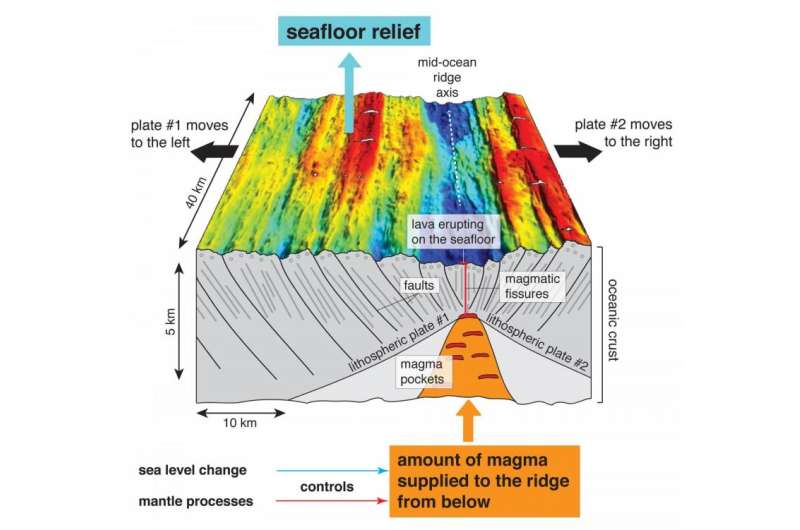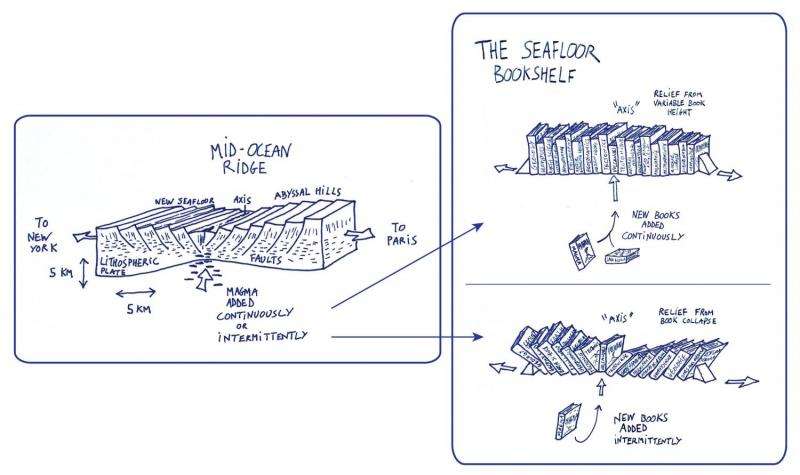October 16, 2015 report
New study argues against climate change as factor in development of abyssal hills

(Phys.org)—A team of researchers from the U.S. and France has published a paper in the journal Science outlining their arguments against the idea of climate change as a factor in development of abyssal hills. They suggest instead that such formations are much more likely the result of undersea fault action and steady magma eruptions.
Most people know that out in the deep ocean there are mountains, which are called ridges, some of which are quite tall—but there are other formations too, similar to foothills on land, which are called abyssal hills—they are not nearly as high as ridges, but are much more numerous. They actually make up the largest number of topological feature on solid Earth. But how they form and came to be the way they are today has remained mostly a mystery, though most scientists agree that it was due to the way magma flows up from below.
Earlier this year, teams of researchers published two papers arguing that abyssal hill formation could be related to climate change—glaciers growing or retreating would have impacted ocean levels they noted, and that they suggested would have impacted the ocean floor below, causing more magma to be released due to pressure changes, resulting at least in part, in the abysmal hill topology we see today. In this new effort, the researchers created three types of models to test this theory.
In the first model, the team modeled the strength of the tectonic plates involved, and whether magma pushed from below could produce such hills. That model showed such a scenario would not work. The second model was designed to show how much new seafloor would be created by a given influx of magma, and found that it would take approximately 100,000 years to produce hills has high as have been observed, a much longer period than that covered by climate change. A third model was built to show how magma pulses driven by climate changes might interact with active faults. Climate change theory would suggest, the team notes, that if magma pulses were involved in shaping the hills, then those near the fastest spreading ridges would have hills on them that were farther apart than slower moving ones, but once again, observation has shown the opposite to be true.

The researchers conclude that it does not appear likely that climate change had much if any impact on the way abyssal hills were formed, and instead argue that the process was slower and more steady.
More information: Sensitivity of seafloor bathymetry to climate-driven fluctuations in mid-ocean ridge magma supply, Science 16 October 2015: Vol. 350 no. 6258 pp. 310-313 DOI: 10.1126/science.aad0715
ABSTRACT
Recent studies have proposed that the bathymetric fabric of the seafloor formed at mid-ocean ridges records rapid (23,000 to 100,000 years) fluctuations in ridge magma supply caused by sealevel changes that modulate melt production in the underlying mantle. Using quantitative models of faulting and magma emplacement, we demonstrate that, in fact, seafloor-shaping processes act as a low-pass filter on variations in magma supply, strongly damping fluctuations shorter than about 100,000 years. We show that the systematic decrease in dominant seafloor wavelengths with increasing spreading rate is best explained by a model of fault growth and abandonment under a steady magma input. This provides a robust framework for deciphering the footprint of mantle melting in the fabric of abyssal hills, the most common topographic feature on Earth.
Journal information: Science
© 2015 Phys.org




















